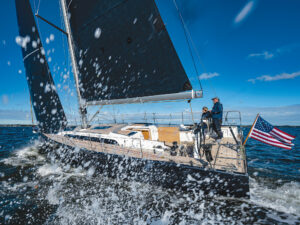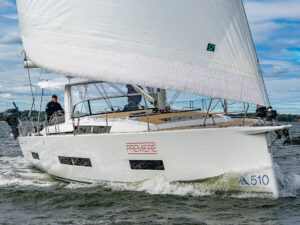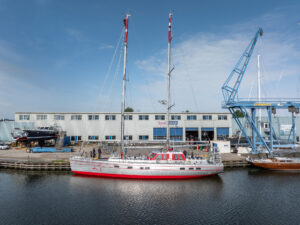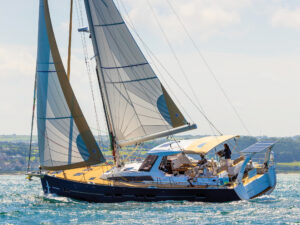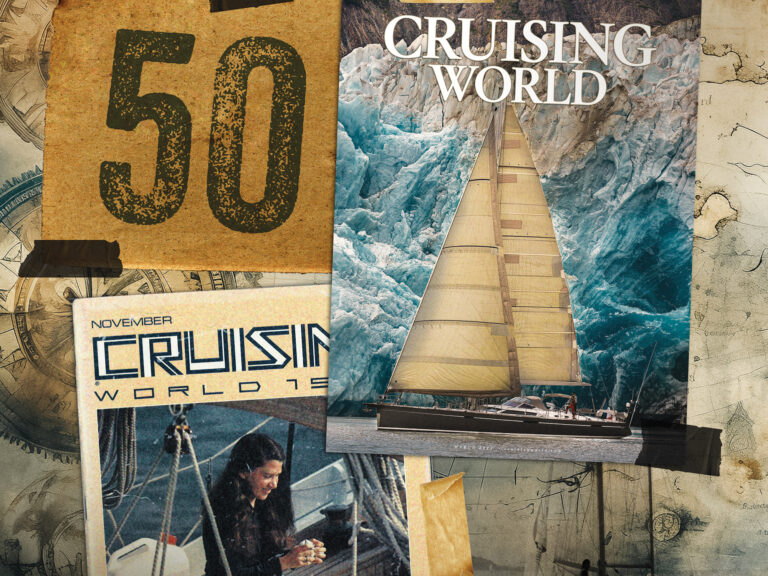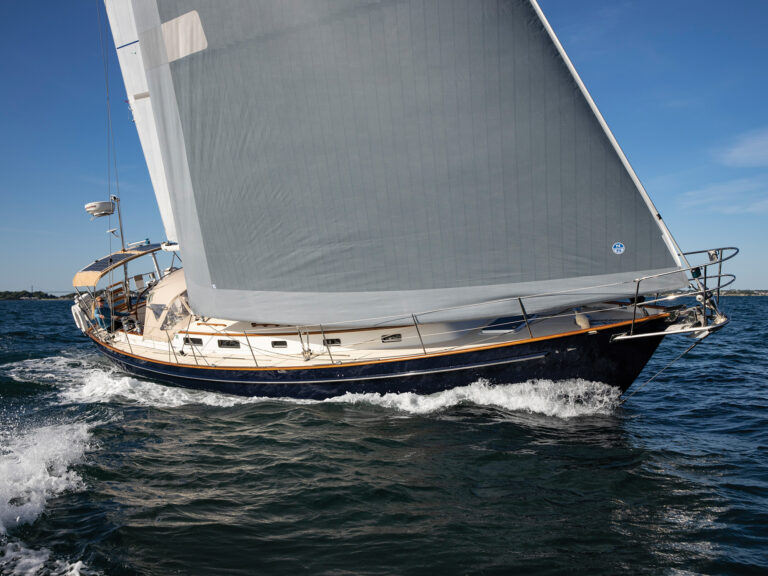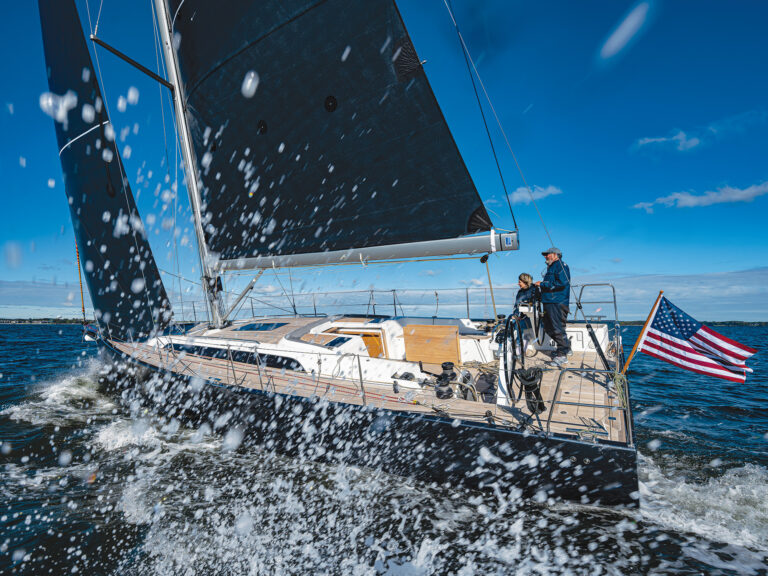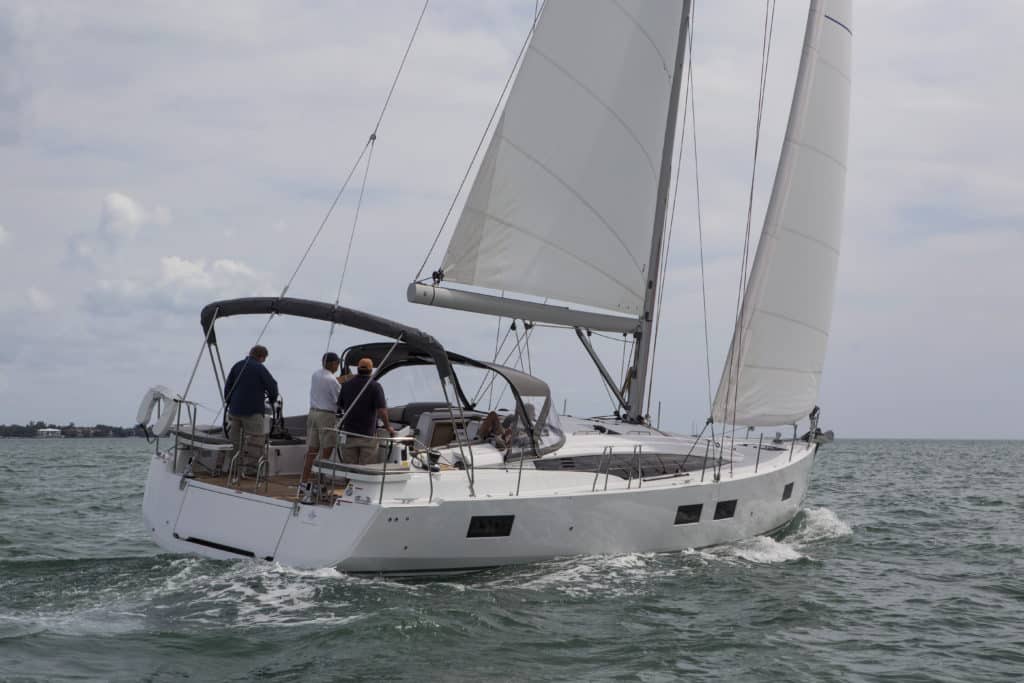
As with other members of the Groupe Beneteau family, Jeanneau became one of the largest builders of production sailboats in the world by designing fine-sailing boats that appeal to a wide audience of sailors. At the top end of its Sun Odyssey line, the 519, for instance, can be ordered with three to five cabins, two to four heads, multiple styles of woods and fabrics, and even an in-line or aft galley, all of which fit within the same hull and deck. Depending on the layout below, the boat appeals to families, groups of friends, racers, cruisers and those looking for a waterfront home, or it can even go into business as a charter boat.
But the French builder took a different tack with its recently launched Jeanneau 51, a boat of about the same size, and the newest and smallest boat in the company’s Yachts range, which includes siblings up to 64 feet. By design, the 51 isn’t for everyone. First and foremost, it’s a couples boat, intended for owners who are ready to spend considerable time aboard, both at anchor and under sail, often alone, though with guests joining them from time to time.
In practice, that translates into a boat that can be easily sailed by a shorthanded crew, with multiple sail-plan options, upscale accommodations below for a couple of couples, and loads of storage space for gear, grub and toys.
Jeanneau introduced the boat to North America last winter at a splendid beach party in downtown Miami during the International Boat Show. The 51 sat anchored just offshore, literally in the spotlight. She looked elegant — and just a bit sporty — with a plumb bow, gracefully arching cabin top, dark-tinted ports and hard chines. In other words, the 51 fit the Yachts range to a T.
All Jeanneau Yachts have been designed by Philippe Briand, with interiors by Andrew Winch, and they share elements such as the “terrace,” where the aft deck between the twin wheels lifts and folds down with the swim platform to create a waterside space, complete with cushions, for lounging by the swim ladder.
Because so much time is spent in the cockpit, a lot of attention was paid to its layout. Forward of the twin wheels, there’s a substantial cockpit table, the aft end of which contains a locker for a life raft. It has teak drop leaves on either side, and there’s a well at its forward end for either storage or a cockpit fridge.
Winches usually found on the cabin top for halyards and reef lines have been moved to either coaming. That’s allowed the designers to put cushioned lounges to either side of the companionway. With the dodger down, they make swell sunbathing spots; with it up, they’re protected from wind and spray, and would be a fine place to relax while on watch or to keep the skipper company.
One more word about the cockpit before we move below: The double-ended mainsheet and jib sheets are led under the deck on either side to stoppers and a winch just forward of each wheel. This setup keeps the clutter of lines from invading those relaxing, and puts them right at the helmsman’s fingertips, where they belong.
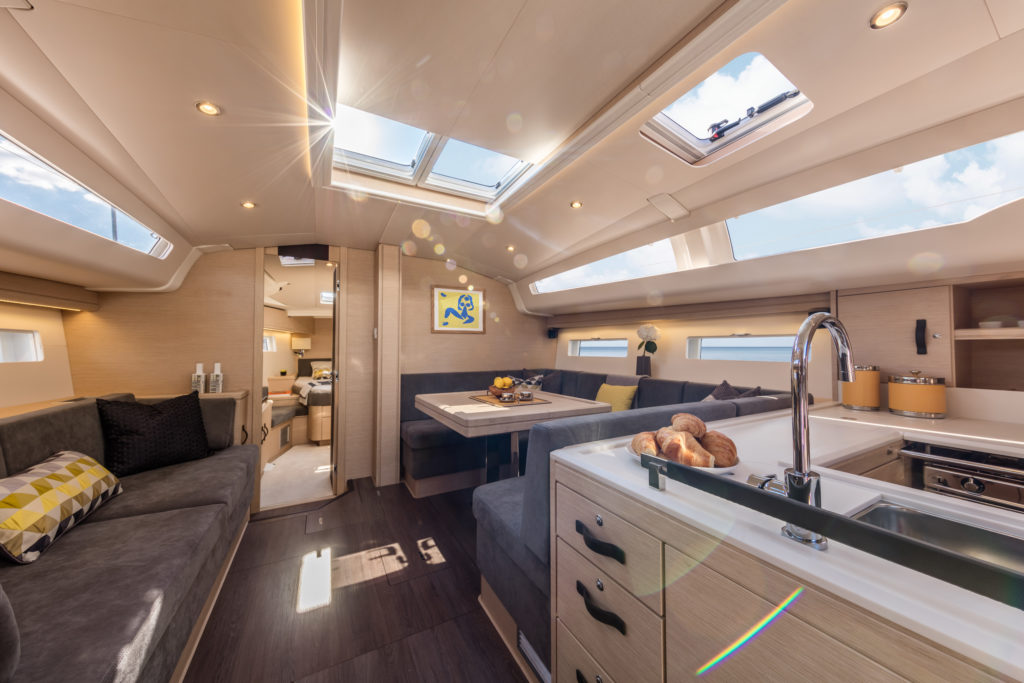
Below, the standard boat, which is what I saw and sailed in Miami, has the owners cabin forward. A pair of overhead opening hatches let the air pour in, while ports in the hull let light do the same. This cabin is large enough to want to spend time in. Nightstands and benches flank a queen-size berth, with two large drawers beneath for storage. There’s more room to stash things in lockers that run fore and aft overhead along the cabin sides, plus a large hanging locker to port as you enter from the saloon. The cabin door is offset to port, which makes room for a large head and separate shower compartment to starboard.
The company calls the guest accommodations aft a VIP cabin. It’s to port of the companionway and has a square queen-size berth that extends to the boat’s centerline. There is impressive headroom over the berth for a boat this size, and the cabin offers plenty of storage space, should the visit be a long one.
There is an option for a smaller, third cabin to starboard, but in the standard layout, this space is a large workshop/storage area that can also be accessed from the cockpit. This could also be fitted out with a single bunk for a captain. Just forward is a utility room, where additional refrigeration or a washer/dryer can be located, or it could be fitted out as a day head.
I found the saloon, with its four opening overhead hatches, port lights in the hull and cabin windows, to be a lovely place to hang out, both at the dock and underway. To port, there’s a full-size, front-facing nav station at the foot of the companionway and a comfortable couch forward. Opposite, the U-shaped dining table is intended to seat six (as is the cockpit table). The galley, with loads of counter space, drawers and cupboards, is just aft, and has the cooking and refrigeration equipment you’d need for living aboard.
The boat I sailed had the standard in-mast furling main and 110 percent genoa, stored on a Facnor furler. There is a fitting on the double anchor roller for downwind sails, and an optional track is available by the mast for a self-tending jib, as well as a provision for adding a removable inner forestay, if one’s desired. This gives an owner many sail choices, depending on conditions.
The 51’s hull is hand-laid solid glass; the deck is resin-infused with a balsa core; high-density plywood is used where hardware is mounted. Keels are cast iron and available in deep (7-foot-5-inch) and shallow (5-foot-8-inch) configurations.
Our test boat had the optional 110-horsepower Yanmar engine with shaft drive. With the throttle down (3,200 rpm), we had plenty of power and cruised at better than 8 knots in a light chop; the boat comes standard with an 80-horsepower Yanmar and saildrive.
But really, the boat was meant to sail. In 10 to 12 knots, with the sails sheeted tight, the 51 heeled onto its chines and scooted along at 7 knots. Off the wind, the speedo dropped maybe a half a knot, hinting that a code zero on a flexible furler would be a sensible investment.
As is often the case with a range of boats that vary in size by just a few feet each, it’s tempting to pick a favorite. I’ve sailed on both the 58 and the 54, and if I were putting my own money down (in this case around $525,000 for a well-equipped model; the base boat’s $405,000), it would be on the 51. To my eye, all the pieces fit as they should. Below, it feels roomy; at the helm, manageable; and under sail, well, it was one sweet ride.
Specifications
LOA: 50’5″ (15.37 m)
LWL: 45’9″ (13.94 m)
Beam: 15’5″ (4.70 m)
Draft: 7’5″/5’8″ (2.26/1.73 m)
Sail Area: 1,163 sq. ft. (108 sq. m)
Ballast: 9,480 lb. (4,300 kg)
Displacement: 31,747 lb. (14,400 kg)
Ballast/Displacement: 0.30
Displacement/Length: 148
Sail Area/Displacement: 18.6
Water: 169 gal. (640 l)
Fuel: 63 gal. (238 l)
Holding: 27 gal. (87 l)
Mast Height: 72′ (21.95 m)
Engine: 80 hp Yanmar
Designer: Philippe Briand/Andrew Winch
Price: $525,000
Jeanneau
410-280-9400
www.jeanneau.com
Mark Pillsbury is CW’s editor.

